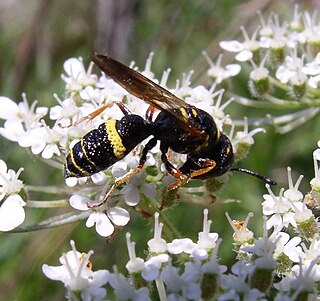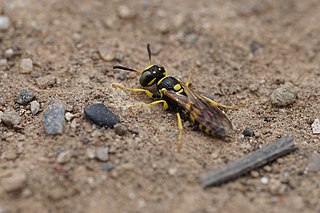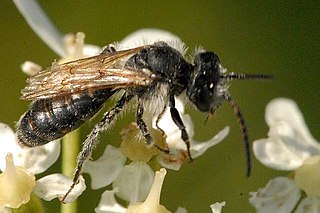Paralysis is a loss of motor function in one or more muscles. Paralysis can also be accompanied by a loss of feeling in the affected area if there is sensory damage. In the United States, roughly 1 in 50 people have been diagnosed with some form of permanent or transient paralysis. The word "paralysis" derives from the Greek παράλυσις, meaning "disabling of the nerves" from παρά (para) meaning "beside, by" and λύσις (lysis) meaning "making loose". A paralysis accompanied by involuntary tremors is usually called "palsy".

Beewolves, also known as bee-hunters or bee-killer wasps, are solitary, predatory wasps, most of which prey on bees, hence their common name. The adult females dig tunnels in the ground for nesting, while the territorial males mark twigs and other objects with pheromones to claim the territory from competing males.

The European beewolf, also known as the bee-killer wasp or the bee-eating philanthus, is a solitary wasp that lives in the Western Palearctic and Afrotropics. Although the adults of the species are herbivores, the species derives its name from the behaviour of the inseminated females, who hunt Western honey bees. The female places several of its paralysed prey together with an egg in a small underground chamber, to serve as food for the wasp larvae. All members of the genus Philanthus hunt various species of bees, but P. triangulum is apparently the only one that specialises in Western honey bees.
Philanthus gloriosus is a species of bee-hunting wasp found west of the 100th meridian in North America, from Medicine Hat, Alberta south across the High Plains and Rocky Mountains to the Mexican states of Chihuahua, Coahuila, Durango, San Luis Potosí, Hidalgo, Mexico City and Puebla.

Philanthus gibbosus, the hump-backed beewolf, is a species of bee-hunting wasp and is the most common and widespread member of the genus in North America. P. gibbosus is of the order Hymenoptera and the genus Philanthus. It is native to the Midwestern United States and the western Appalachians. P. gibbosus are often observed to visit flowers and other plants in search of insect prey to feed their young. The prey that P. gibbosus catches is then coated in a layer of pollen and fed to the young wasps.
Philanthus politus is a white-striped species of bee-hunting wasp.

Philanthus pulchellus is a species of bee-hunting wasp of the Iberian Peninsula. Males are territorial and establish territories in nesting areas of females, or in the case of smaller males that are unable to do so, nearby. Females are generalist predators of bees and wasps, including conspecifics, and store the prey in their underground nest.

Philanthus multimaculatus is a species of bee-hunting wasp, or beewolf, found from British Columbia and Alberta south to Zacatecas and San Luis Potosi.
Philanthus coronatus is a species of bee-hunting wasp of Europe and the Middle East, of which there are three known subspecies:

Philanthus ventilabris is a species of bee-hunting wasp found throughout North America. It is a solitary species.

Hedychrum rutilans is a species of cuckoo wasps. The species occurs primarily in Austria, Italy, Bulgaria, Greece, France, Poland, Portugal, Spain, Switzerland and in North Africa. The head and thorax are metallic green with red spots, while the abdomen is red. The color is more green and partially golden in the male and more extensively golden-red in the female. The body is somewhat hairy.
The common name digger wasp is a broad term which may refer to any member of the parasitoidal wasp families:

Lasioglossum zonulus is a species of sweat bee in the family Halictidae. It is found in Europe and North America. While the name has historically been misspelled "zonulum", the original name, zonulus, is a noun and does not change spelling under Article 31 of the ICZN, and some sources have recognized this and adopted the correct spelling.
Philanthus pacificus is a species of wasp in the family Philanthidae. It is found from southwestern British Columbia to Baja California and Sonora.
Philanthus sanbornii is a species of wasp in the family Philanthidae. It is found in North America.

Sphaerophoria philanthus is a species of syrphid fly in the family Syrphidae. It is found in Europe.
Philanthus solivagus is a species of wasp in the family Philanthidae. It is found in North America.
Philanthus lepidus is a species of wasp in the family Philanthidae. It is found in North America. It creates false burrows in its nests, and preys upon Halictidae bees.








